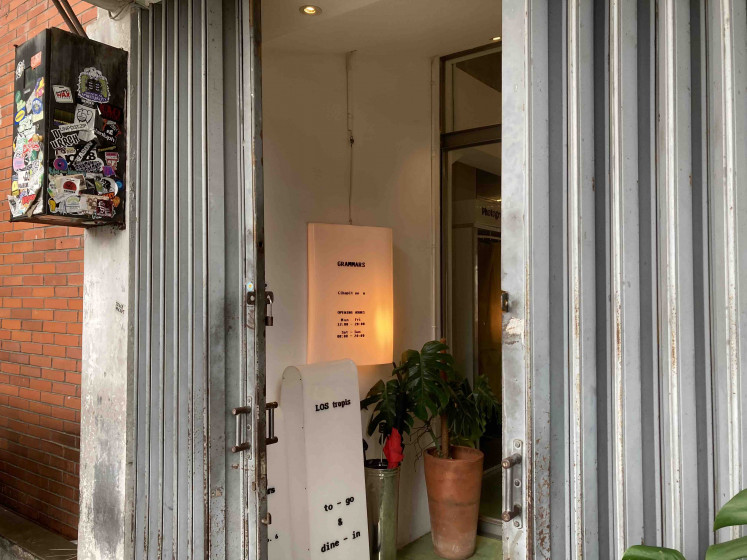Popular Reads
Top Results
Can't find what you're looking for?
View all search resultsPopular Reads
Top Results
Can't find what you're looking for?
View all search resultsIs Jl. Cihapit’s newfound trendiness another case of gentrification?
Change text size
Gift Premium Articles
to Anyone

A
s the iconic traditional market and its surroundings in Bandung face a surge of tourists in search of a hip scene, concerns have been raised about gentrification and shifting demography.
In the not-so-distant past, few people in Bandung would have thought of spending leisure time on Jl. Cihapit after sundown. Aside from small warung (kiosks), there was barely anything left to do after the traditional market at its center closed for the day.
Recently, however, the area has found new fame as a center of hipness. With many visitors posting images of their time in the area on social media, the neighborhood’s face has become younger. Creative businesses and communities sharing the same ideals and aesthetic sensibilities started moving into the area, turning it into one of Bandung’s trendiest areas.
With relatively walkable areas consisting of a mix of old, heritage businesses and new ones, Jl. Cihapit is a neighborhood that resembles a miniature city. Its sustainability, however, is often questioned by Bandung’s creative communities and even those who have built new, successful businesses there. The question is whether its current form is at odds with the neighborhood’s preexisting socioeconomic structure.

Graveyard shift
“Keu’eung, Mas [eerily quiet, brother],” said Anton, the proprietor of Trikuto, a coffee shop on Jl Cihapit, regarding how the situation there used to be after peak morning time. He used a Sundanese word.
“We would rush to close our shop at 5 p.m. [...After dark,] no one would come here except the neighbors.”
The space was previously run by his father-in-law, who still owns it, and his siblings from 1965.
“It was a toko serba ada [traditional grocery store] back then. The shop was really full of stuff,” said Anton as he gestured toward the now sparsely fitted interior of the space. He started renting the space with his wife when the in-laws closed their business in 2007.
Faza Chu, the owner of the artisan bakery Seroja Bake, located just around the corner from Trikuto, remembered Jl. Cihapit similarly.
“It was like a ghost town after 6 p.m. There was practically nothing here, but if you moved toward Jl. Riau, the road was usually hectic,” said Faza.
Jl. Cihapit, compared to other areas that branch along Jl. Riau, was overlooked mainly because of the restrained pattern of activities in the area. The presence of Pasar Cihapit and its proximity to SDN Sabang elementary school defined the activities in the morning, when people would drop off their children at school or go grocery shopping.
The area’s activities at the time adhered to the operating times of the merchants inside the traditional market. Trikuto’s mornings, for example, were always filled with customers. This, then, grew organically into a community.
“The saddening thing was that it would all die after 3 p.m.,” said Anton. He recalled counting only two cars passing through the area in an hour. “Because it wasn’t the main road. But I kept on insisting on staying open until 9 p.m.”
He said neighbors used to liken his shop’s situation to a graveyard.
Anton noted that things began to improve after Grammars, a gift shop focusing on stationery and curated goods, opened in Cihapit.
“Grammars made things livelier here,” he said.
Coming into vogue
Creative entrepreneurs Ardo Ardhana, Zanun Nurangga and Artiandi Akbar opened Grammars in Cihapit in March 2020, two lots down the road from Trikuto, not long before COVID-19 lockdowns rolled out.
“We started without any business plan,” said Ardo. Grammars took over the place once used by the now scaled-down, longstanding restaurant Aloha. The entrepreneurs shared the space with other tenants such as Los Tropis and Gang Nikmat.
Anton recalled the group of friends visiting Trikuto notifying him that they were about to open, to which Anton responded with excitement.
“There’s a fault line on Jl. Cihapit that divides it into two parts,” said Ardo, with the first covering the northern section connecting directly to Jl. R.E. Martadinata and the other right in front of the police station, where Trikuto and gift shop Grammars reside.
The latter one, Ardo noted, was acknowledged by Anton as “always quiet”.
But things changed after Grammars.
“I can’t deny that Grammars introduced a new group of people here,” said Anton.
Anton tried to foster communication among the tenants of the neighborhood. These efforts were not all successful, as some tenants simply never showed up and others had little interest in building relationships with others.
New, brand-aware places of business started opening up, such as the cheekily named noodle joint Tjo Kin, an old spelling for a slang term sometimes used to refer to Chinese-Indonesians, not always in a sympathetic manner. Bakers Seroja Bake and book-store-turned-coffee-shop chain Kopi Toko Djawa also arrived, as well as humbler businesses, such as Nasi Telur Sumber Rezeki.
User-generated content on social media such as TikTok and Instagram followed, feeding on the masses’ sense of discovery and eventually driving more foot traffic into the area. Ardo noted that Grammars recorded an average of 500 visitors daily on weekends and 250 people on weekdays.
Some of the tenants interviewed raised concerns that the newfound trendiness of the area would push rents higher.
The neighborhood has grown to such an extent that more prominent players, such as Taiwanese ice cream chain Mixue, have opened up shop there.

Intertwined
The neighborhood’s once run-down appearance did not necessarily mean it was poor. Cihapit is quite complicated, as it is located in a wealthier area that branches off from one of Bandung’s most extensive, highly commercialized roads. Conflicting recollections of its past are common. Artiandi, for instance, remembers Pasar Cihapit as a market that had grown to cater more to the upper classes.
Old residents in the neighborhood, according to Faza, were usually old money.
“It was either that or really poor,” he said.
However, Jl. Cihapit had a very robust “informal structure”, Artiandi said, where the locals organized to withstand or adapt to changes over time.
One of the area’s older residents, Saipudin, who has sold seasonal fruits from a 2-by-1.5 meter stall since the 1980s, is an example of the neighborhood’s tightly woven informal structure. He closed his stall in response to plummeting sales during COVID-19 lockdowns and managed to return a year later at the exact same location, even amid the budding trendiness.
Most of the street vendors there, Saipudin included, have been around “since forever”, said a passerby.
“I moved here in 1962 from Cikijing, Majalengka,” said Saipudin, who is now living on his own in a rented single room just off Jl. Tongkeng. Saipudin relies entirely on his daily income from selling fruits from his stall in front of a shophouse.
He commented that the sales were getting better. “It’s good to see new [shops] and lots of new culinary places now”.
Saipudin is not currently worried about being displaced, and the lower class in the neighborhood are, at the moment, flourishing as visitors flock to the area. But the specter of future rent hikes looms.
Ardo and Anton share the same view regarding possible price hikes, which could displace the middle, professional class currently renting out larger spaces on Jl. Cihapit. Ardo noted a lack of control from the local governing body, PD Pasar, that could end in steep increases in the price of rentals through subletting.
Faza said the gentrification process had already begun when the current landowners acquired the land where their properties and shops now stand.
“In terms of price hikes, I think the more appropriate term to use here would be normalization,” said Faza. The current trend in the neighborhood, he said, justified the prices.
“It’s still within our estimates, but if you’re asking whether or not we’ll still be here after five years, we might not be.”









